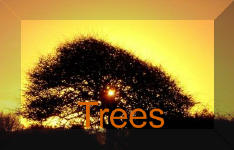BACK TO


Tree layer
The fact that the tree layer is so easily discernible in most British woodlands is a commentary on the paucity of species occurring here. In the tropical rain forests of central and South America (some of the densest on earth) many trees of different species, heights, and ages all grow together, forming a canopy of great complexity. The most important ecological effect of the tree canopy is in controlling the mount of light that can penetrate below.
Thus, in beechwoods, the dense foliage shuts out much of the illumination during the important growth period from April to October with the result that shrub and field layers are frequently absent. The same is true of coniferous forests such as pine or spruce frequently planted by man but here the situation is more extreme since the trees i.e. evergreens and therefore retain their leaves till the year round.
By contrast, mixed deciduous woods are more open (particularly if they have been artificially thinned to promote strong growth by reducing competition) and the high illumination encourages dense growths of shrubs and herbs .
Shrub layer
This ranges from small woody plants such as bramble, and privet, to spreading trees like plants such as hazel,, and holly, which can reach a height of 7 m or more. Like the trees above them, the shrubs can also exert a strong shading effect, as is well illustrated by a mature hazel coppice in mid-summer which can give the impression almost total darkness inside.
Field layer
For the herbaceous annuals and perennials living below the shrub layer, it is often a race against time to ensure the setting of seed before light shortage intervenes. This is particularly true of species which rely on insect pollination such as the wood anemone, Anemone nernorosa,.
An outcome of this situation is that a distinct flowering sequence is usually observable among plants of the field layer from the early spring onwards. First to appear in February are the primrose, Primula vulgaris, and celandine, Ranunculus ficaria, then the wood anemone, Anemone nemorosa, in March. Bluebells, Endyrnion nonscriptus ,flower in April and continue into the deep shade period of early May, while plants such as meadowsweet, and valerian, are able to flower successfully in the dim light of summer from June onwards.
It should be noted that the flowering sequence characteristic of the field layer plants in spring is not a succession in the generally accepted sense. Rather it represents a subtle sequential adjustment of the behavior pattern of different species in response to changing environmental conditions.
Living apparently unccessfully within the field layer are sometimes to be found plants usually associated with areas of high light intensity, An example is the rosebay willowherb, a colonist of forest clearings, particularly where burning has occurred. However, more careful observation will show that although these plants succeed in growing and indeed extend their range via underground rhizomes, they are incapable of flowering and must therefore have arrived as seeds from elsewhere.Ground layer
This consists of a wide variety of lowly plants such as mosses, liverworts, and lichens which abound in areas where there is sufficient moisture, for example the bark of tree trunks, the banks of ditches, on rotting timber and so forth. Nearly all these species are able to tolerate a low level of light intensity.
Another important component of the ground layer is invisible for most of the year the fungi. These are mostly basidiomycetes, whose spore-bearing bodies (toadstools) are a feature of woodland in October. Many of them are saprophytic, Some form symbiotic associations with trees and shrubs (mycorrhiza), while others such as the Honey fungus, are serious parasites of many woodland trees such as oak,The litter layer
Covering the surface of the soil and particularly evident in , areas of high leaf-fall such as woodland, is a zone of semi-decomposed plant material known as the litter layer. Under trees whose leaves decompose slowly, this can he 50mm deep more.
The litter has an important influence on the soil below, as it provides a continuing source of humus and helps to maintain the level of humidity at the surface. Although subject to greater environmental fluctuations than the soil underneath, particularly in temperature and humidity, it is nonetheless a favored habitat for many small arthropods such as springtails.
Moisture is no doubt the main abiotic factor influencing animal distribution in the litter layer and typical cryptozoic species such as woodlice, centipedes and millipedes show a negative taxis to dry air and light. In woodlice, high humidity (possibly associated with low temperature) tends to reduce activity and hence prevents the animals from wandering too far from their optimum conditions. This may also account for the large local aggregations of woodlice and other arthropods that frequently occur underneath rotting logs and large stones.
It has been shown that different species vary in their degree of drought tolerance. like their counterparts in the top soil, most of them only venture out after dark but even then, they can only withstand the reduced humidity for relatively short periods. Among woodlice, the most relevant species belong to the genus Armadiflidium, so called on account of their capacity to roll up into a bail like a miniature armadillo. Curiously, these litter layer animals tend to become positively phototactic in dry air and this leads to a kind of do or die behavior pattern. In the event of their habitat becoming too dry to sustain then,, they tend to react by wandering about in the open until they either find a more suitable site or perish in the attempt.